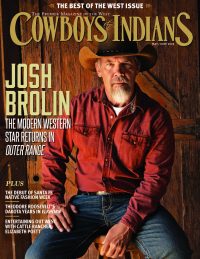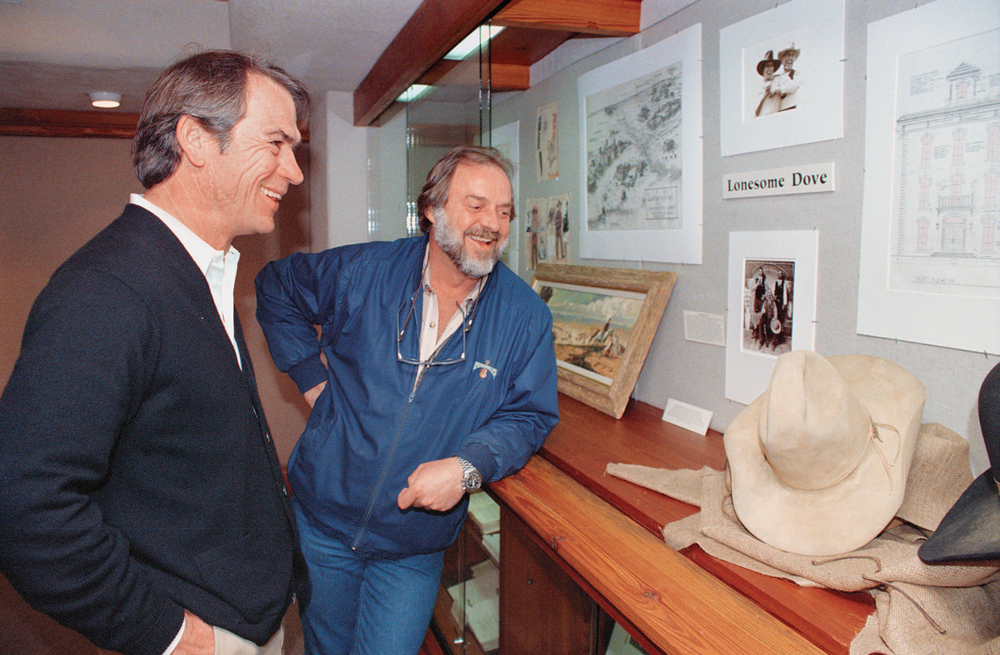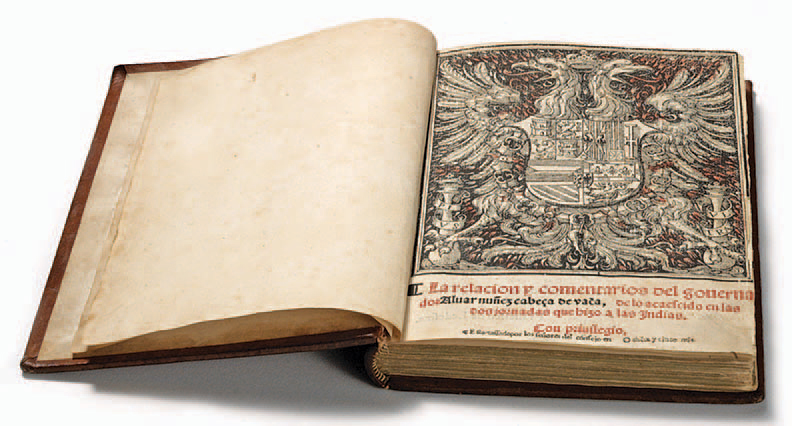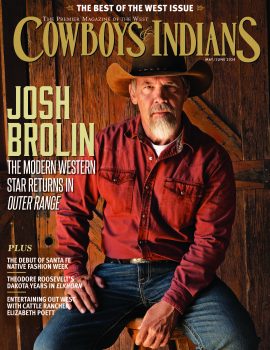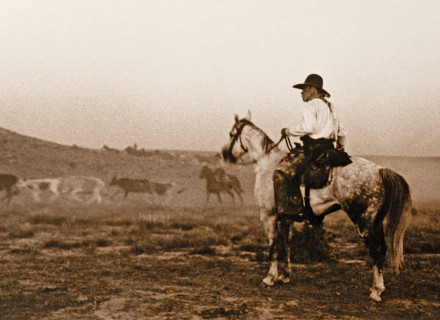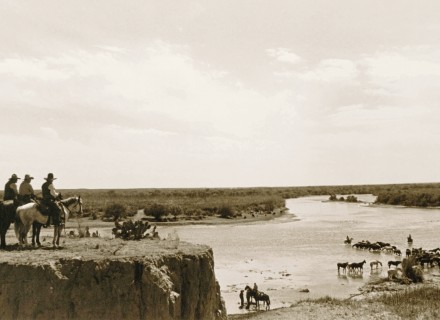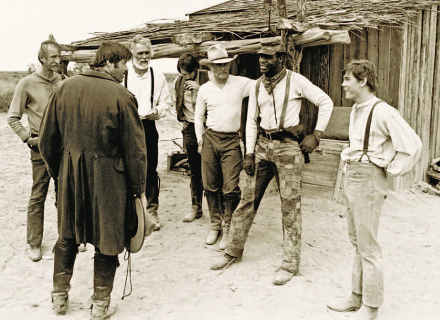The man who wrote the script for Lonesome Dove has created a worthy tribute not only to the TV series itself, but to the vast Southwest that inspired it.
For many fans of the classic Lonesome Dove miniseries, the room on the seventh floor of the Albert B. Alkek Library at Texas State University in San Marcos seems almost like a shrine.
“Some people actually get real weepy when they come in here,” says Bill Wittliff, scriptwriter and coproducer of the 1989 television epic based on the Pulitzer Prize-winning novel by Larry McMurtry. “They come from all over the world, like they’re paying their respects [to Gus McCrae and Woodrow Call]. Or like they’re on a pilgrimage.”
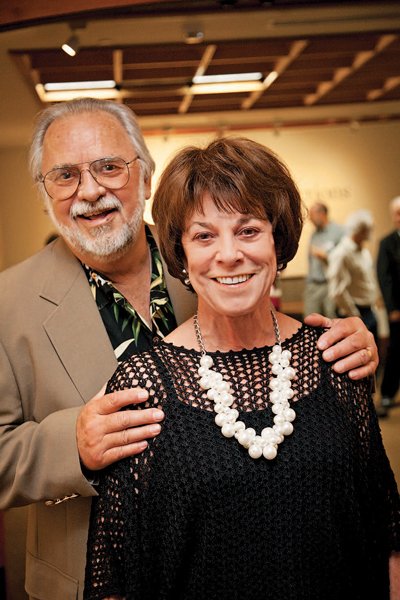 And what do these pilgrims see in the Lonesome Dove exhibition room? A representative collection of props and costumes, screenplay drafts and photographs, all donated by various participants in the original TV production. Arguably the most striking artifact on view: the one-legged prop corpse of Texas Ranger turned cattle driver Augustus “Gus” McCrae (memorably portrayed in the miniseries by Robert Duvall). And yes, rest assured, the Hat Creek Cattle Company sign that proudly proclaims “We Don’t Rent Pigs” is also prominently displayed.
And what do these pilgrims see in the Lonesome Dove exhibition room? A representative collection of props and costumes, screenplay drafts and photographs, all donated by various participants in the original TV production. Arguably the most striking artifact on view: the one-legged prop corpse of Texas Ranger turned cattle driver Augustus “Gus” McCrae (memorably portrayed in the miniseries by Robert Duvall). And yes, rest assured, the Hat Creek Cattle Company sign that proudly proclaims “We Don’t Rent Pigs” is also prominently displayed.
Visitors can mosey through the area at their own pace while the stirring Lonesome Dove score composed by the late Basil Poledouris plays in the background. But even those who dawdle don’t necessarily stay very long: The Lonesome Dove exhibition room is, well, just a room. And not a terribly large one.
“We really need to double the size of this place,” Wittliff says. “We’ve got a lot more stuff to show. It’s just that we’ve also got a lot of other things that need our attention.”
Indeed, the Lonesome Dove room is only a small part of the The Wittliff Collections, which currently occupy 6,600 square feet of exhibition space in the Alkek Library. Founded by Wittliff and his wife, attorney Sally Wittliff, the eclectic archive is devoted to preserving and celebrating the creative legacy of the Southwest and, as stated on The Wittliff Collections website, “to fostering ‘the spirit of place’ in the wider world through the acquisition of significant archives and works of the Southwest’s literature, film and music, as well as the photography of the Southwest and Mexico.”
In the beginning, there was the Southwestern Writers Collection, which was established by the Wittliffs at Texas State University in 1986 and moved into its permanent location at the Alkek Library in 1990. Over the ensuing years, this archive has come to include the private papers and original manuscripts of authors, screenwriters, playwrights, and songwriters such as Sam Shepard, Cormac McCarthy, Edwin “Bud” Shrake, Larry McMurtry, Willie Nelson, Elizabeth Crook, Jim Hightower — and, of course, Bill Wittliff, an accomplished author and photographer whose other screenwriting credits include Raggedy Man (1981), Barbarosa (1982), Legends of the Fall (1994), The Perfect Storm (2000), and A Night in Old Mexico (2013).
The Southwestern & Mexican Photography Collection — originally known as the Wittliff Gallery of Southwestern & Mexican Photography — was established in 1996 and includes works ranging from the 19th century to the present day. Kate Breakey, Keith Carter, and Graciela Iturbide are among the renowned photographers represented in the collection, which also contains what is billed as the largest archive of modern and contemporary Mexican photography in the United States.
“When it comes to photography, we sometimes find we’re dealing with a learning curve,” Wittliff says, only half-smiling. “Like when we had our inaugural exhibit and opened the photo-graphic collection, we had a picture from Earlie Hudnall Jr., a really, really terrific photographer who did some amazing stuff in the Third Ward of Houston. Well, he took this picture of this little girl sitting on the curb with an American flag — just a wonderful picture, beautiful. And when we had it at our exhibit, this lady I know — an exceedingly wealthy person, very cultured — she came over to me and said she wanted to buy that picture for a particular place in Austin. She said, ‘How much would it cost to get one like that, a print?’ And I said, ‘Nine hundred dollars.’ And she said, ‘Nine hundred dollars for a photograph?’ And I said, ‘That’s art.’ ”
Wittliff laughs before capping off his story with a happy ending. “So she bought one. And then she got it. In fact, she got it so well, she started collecting photography.”
Click on the image above to view the slideshow for selections from the Wittliff Collections.
Spreading the good word in such a manner, Wittliff adds, is a prime objective for the collections that bear his name: “There’s that old adage that states whatever a culture honors, the artists will strive to produce. We do try to bring honor to quality writing and quality photography and quality thought. That’s an important thing for any collection to try to do.”
The Southwestern Writers Collection and the Southwestern & Mexican Photography Collection were officially joined as The Wittliff Collections in 2007, two years before a major expansion program nearly tripled the exhibition areas. Now as many as 300 photographs can be on view at any given time, and six to 10 exhibitions of various kinds are presented annually.
“Essentially,” says The Wittliff Collections curator Steven L. Davis, “we are about the creative act. Creative writing, creative photography. Of course, we also include some journalism, some historical documents. We tap into history directly or indirectly, here and there, especially through fiction that we have in the collection. Generally, though, we’re more on the creative side than on the documentary.”
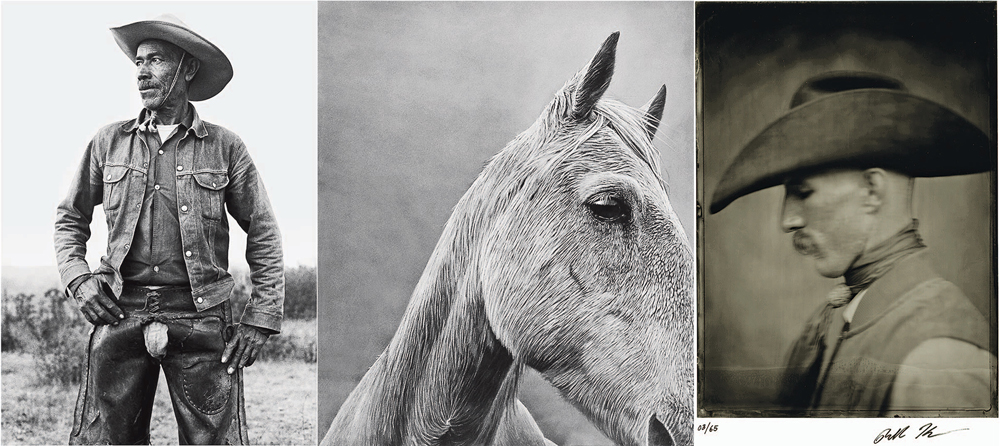
Photography: (from left) Bill Wittliff’s photograph Refugio “Cuco” Salas, Remudero, White Horse, a hand-painted photograph by Kate Breakey, Tom “Stretch” Bowerman by Texas photographer Robb Kendrick. Courtesy the Wittliff Collections, Texas State University
Throughout the year, academics and researchers trek to San Marcos to attend lectures and symposiums, and to examine the exhibits and archives of The Wittliff Collections — a multifaceted treasure trove that offers such diverse attractions as vintage photographs by Farm Security Administration documentarian Russell Lee, the production archives of the Texas-based animated series King of the Hill, and an extensive compendium of scripts, playbills, and publicity materials related to African-American playwrights and theaters in the Southwest.
“The archives are available to anyone who has an interest in the collections,” Davis says. “We do ask them to make an appointment, so we can make their trip easier. But otherwise, once they’re here they can look at whatever they want to see. Really, the collections are in constant use.”
Since The Wittliff Collections obtained the papers of author Cormac McCarthy (All the Pretty Horses, No Country for Old Men), “That’s been the most requested and most researched collection that we have here,” Davis says. “Researchers come from Japan, from Russia, from all over Europe and the United States to study his papers.”
Another popular attraction: collections of recordings, sheet music, instruments, and even wardrobe items related to the rich musical cultures of Texas — country, swing, polka, Tejano, rock-and-roll, and more. If you’ve ever had a hankering to see a cowboy hat worn by Bob Wills while he performed with his Texas Playboys or listen to early studio recordings by Willie Nelson, a visit to the Alkek Library should be on your bucket list.
And once you get there, you’ll find there’s a lot more to enjoy, and many ways to be inspired.

This paddle was used by author John Graves on his historic 1957 canoe trip down the Brazos River that inspired his acclaimed nonfiction work Goodbye to a River. Courtesy the Wittliff Collections, Texas State University.
“First and foremost,” Wittliff says, “we want this to be a place that preserves the cultural and historical artifacts of Texas and the Southwest and Mexico. But more important, we want it to be a place of inspiration. A place where people who have the urge to create — but not yet the courage — can come and see how other writers struggled to find just the right word, just the right sentence to express their intention.
“When you see how everybody just worked at it, you say, ‘Well, I can do that.’ All of a sudden you realize that for everybody, it doesn’t just pour from God. You have to endure. I know absolutely if I’d walked into a place like this when I was 16 or 17, I would have had the courage to try to write long before I did, because I would have seen that so much of it is just sitting and trying and working.
“I think that in both collections, in the writing collection, and also in the photography collection, those are the two main things we emphasize — the preservation and the inspiration.”
All that, and the enduring appeal of Lonesome Dove.
The Wittliff Collections are housed at the Albert B. Alkek Library at Texas State University in San Marcos, and admission is free. For information on current and online exhibitions, events, and research, visit thewittliffcollections.txstate.edu.
Photography: (all images) Courtesy the Wittliff Collections, Texas State University; (inset) The Wittliff Collections were founded by Bill Wittliff and his wife, attorney Sally Wittliff/Cary White © 1988; (slideshow) Courtesy the Wittliff Collections, Texas State University; Necklace by Keith Carter © 2003.
From the January 2015 issue.



